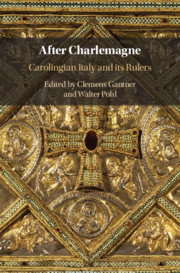Book contents
- After Charlemagne
- After Charlemagne
- Copyright page
- Contents
- Contributors
- Additional material
- 1 Italy after Charlemagne
- 2 A Brief Introduction to Italian Political History until 875
- Section I Was There a Carolingian Italy?
- Section II Organizing Italy
- Section III Carolingian Rulers
- Section IV Cities, Courts and Carolingians
- 12 A Byzantine Cuckoo in the Frankish Nest?
- 13 Urbanism as Politics in Ninth-Century Italy
- 14 Rome and the Others
- 15 Between the Palace, the School and the Forum
- Bibliography
- Index
14 - Rome and the Others
Saints, Relics and Hagiography in Carolingian North-Eastern Italy
from Section IV - Cities, Courts and Carolingians
Published online by Cambridge University Press: 03 December 2020
- After Charlemagne
- After Charlemagne
- Copyright page
- Contents
- Contributors
- Additional material
- 1 Italy after Charlemagne
- 2 A Brief Introduction to Italian Political History until 875
- Section I Was There a Carolingian Italy?
- Section II Organizing Italy
- Section III Carolingian Rulers
- Section IV Cities, Courts and Carolingians
- 12 A Byzantine Cuckoo in the Frankish Nest?
- 13 Urbanism as Politics in Ninth-Century Italy
- 14 Rome and the Others
- 15 Between the Palace, the School and the Forum
- Bibliography
- Index
Summary
Within their projects of religious beliefs and practices’ standardization, Carolingian rulers looked to Rome as an area providing authoritative traditions, norms and objects. Roman saints and their relics perfectly matched the Carolingian politics on sanctity and its exploitation. Yet Roman relics were not the only ones circulating in the empire. For instance, relics of different origins were assignedimportant roles in the social and political integration of Italian local elites within the landscape of Carolingian power. This chapter focusses on north-eastern Italy, underlining how its Carolingian bishops and counts used and promoted saints and relics by the means of hagiographical texts in order to raise consensus for themselves and the authority they represented. First I consider the use of local saints by the bishops of Verona as tools for self-legitimation and for pursuing personal aims. Then I turn to the role of hagiography in the dispute for primacy between Aquileia and Grado, a case of contrasting re-elaborations of previous texts and traditions in order to support claims in the present. Finally, attention is paid to the transfer of a Roman holy body to Cysoing by marquis Eberhard of Friuli, and to the strategies of memorial reshaping connected to it.
- Type
- Chapter
- Information
- After CharlemagneCarolingian Italy and its Rulers, pp. 219 - 249Publisher: Cambridge University PressPrint publication year: 2020



